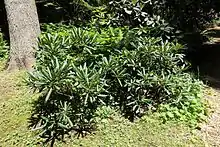Rhododendron beesianum
Rhododendron beesianum (宽钟杜鹃) is a rhododendron species native to northeastern Myanmar, southeastern Tibet, and southwestern Sichuan and northwestern Yunnan in China, where it grows at altitudes of 3,200–4,500 m (10,500–14,800 ft). It is an evergreen shrub or small tree that grows to 2–9 m (6.6–29.5 ft) in height, with leathery leaves that are oblanceolate to oblong-lanceolate, and 10–25 × 3–7 cm in size. The flowers are pinkish white to pink.
| Rhododendron beesianum | |
|---|---|
 | |
| Scientific classification | |
| Kingdom: | Plantae |
| Clade: | Tracheophytes |
| Clade: | Angiosperms |
| Clade: | Eudicots |
| Clade: | Asterids |
| Order: | Ericales |
| Family: | Ericaceae |
| Genus: | Rhododendron |
| Species: | R. beesianum |
| Binomial name | |
| Rhododendron beesianum | |
It was discovered in 1902 by the Scottish botanist George Forrest, who sent seeds home. However, though hardy, it is not often found in cultivation.[1]
References
- "Rhododendron beesianum". Trees and Shrubs Online. International Dendrology Society. Retrieved 22 April 2021.
- Diels, Notes Roy. Bot. Gard. Edinburgh. 5: 214. 1912.
This article is issued from Wikipedia. The text is licensed under Creative Commons - Attribution - Sharealike. Additional terms may apply for the media files.